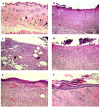Wound Healing Activity of a Traditionally Used Poly Herbal Product in a Burn Wound Model in Rats
- PMID: 26473072
- PMCID: PMC4601203
- DOI: 10.5812/ircmj.19960
Wound Healing Activity of a Traditionally Used Poly Herbal Product in a Burn Wound Model in Rats
Abstract
Background: Burns are known as one of the most common and destructive forms of injury with a vast spectrum of consequences. Despite the discovery of various antibacterial and antiseptic agents, burn wound healing still has remained a challenge to modern medicine. Plants, with a valuable traditional support, have been considered as potential agents for prevention and treatment of disorders in recent years. However, modern scientific methods should be applied to validate the claims about the therapeutic effects of the herbal products.
Objectives: This study was conducted to evaluate the wound-healing activity of a poly herbal cream (PHC), retrieved from Iranian Traditional Medicine (ITM), in a rat burn wound model in Iran.
Materials and methods: In this experimental study, PHC containing aqueous extracts of Malva sylvestris and Solanum nigrum leaves and oily extract of Rosa damascena petals was used. Second-degree burn wounds were induced in four groups of five rats each. Group 1 received no treatment while groups 2, 3 and 4 were given cream base, silver sulfadiazine (SS) 1% and PHC, respectively to compare the efficacy of PHC with the negative and positive control groups. The percentage of wound healing on days 2, 6, 10 and 14 and histopathological parameters of healed wounds on the 14th day were assessed. Antioxidant and antimicrobial activities of PHC were evaluated using 2, 2-diphenyl-1-picrylhydrazyl (DPPH) and micro-dilution methods, respectively.
Results: There was a significant improvement in healing percentage of PHC-treated rats in comparison to the other groups at the end of the treatment period (87.0% ± 2.1% for PHC in comparison to 32.2% ± 1.6%, 57.0% ± 5.3% and 70.8% ± 3.5% for the control, cream base and SS groups, respectively). Moreover, the healed wounds in PHC-treated animals contained less inflammatory cells and had desirable re-epithelialization with remarkable neovascularization. In addition to the antioxidant activity, PHC exhibited antibacterial effect against Staphylococcus aureus.
Conclusions: Poly herbal cream experimentally and histopathologically revealed a burn wound healing activity probably due to the antioxidant, anti-inflammatory and antimicrobial activities of its phytochemical contents. Therefore, this study confirms the use of M. sylvestris, S. nigrum and R. damascena in burn prescriptions in ITM.
Keywords: Burn Wound Healing; Iranian Traditional Medicine (ITM); Malva sylvestris; Rosa damascena; Solanum nigrum.
Figures

Similar articles
-
Formulation of a Traditionally Used Polyherbal Product for Burn Healing and HPTLC Fingerprinting of Its Phenolic Contents.Iran J Pharm Res. 2016 Winter;15(1):95-105. Iran J Pharm Res. 2016. PMID: 27610150 Free PMC article.
-
Globularia alypum methanolic extract improves burn wound healing process and inflammation in rats and possesses antibacterial and antioxidant activities.Biomed Pharmacother. 2016 Dec;84:1488-1495. doi: 10.1016/j.biopha.2016.11.051. Epub 2016 Nov 19. Biomed Pharmacother. 2016. PMID: 27876335
-
Effect of Malva sylvestris cream on burn injury and wounds in rats.Avicenna J Phytomed. 2015 Jul-Aug;5(4):341-54. Avicenna J Phytomed. 2015. PMID: 26909337 Free PMC article.
-
Medicinal plants and their natural components as future drugs for the treatment of burn wounds: an integrative review.Arch Dermatol Res. 2014 Sep;306(7):601-17. doi: 10.1007/s00403-014-1474-6. Epub 2014 Jun 4. Arch Dermatol Res. 2014. PMID: 24895176 Review.
-
The effects of natural compounds on wound healing in Iranian traditional medicine: A comprehensive review.Complement Ther Clin Pract. 2021 Feb;42:101275. doi: 10.1016/j.ctcp.2020.101275. Epub 2020 Dec 1. Complement Ther Clin Pract. 2021. PMID: 33429123 Review.
Cited by
-
Polyherbal combination for wound healing: Matricaria chamomilla L. and Punica granatum L.Daru. 2021 Jun;29(1):133-145. doi: 10.1007/s40199-021-00392-x. Epub 2021 May 9. Daru. 2021. PMID: 33966255 Free PMC article.
-
Efficacy of topical application of standardized extract of Tragopogon graminifolius in the healing process of experimental burn wounds.J Tradit Complement Med. 2018 Apr 27;9(1):54-59. doi: 10.1016/j.jtcme.2018.02.002. eCollection 2019 Jan. J Tradit Complement Med. 2018. PMID: 30671366 Free PMC article.
-
Evaluation of Wound Healing Activity of 80% Methanol Root Crude Extract and Solvent Fractions of Stephania abyssinica (Dill. & A. Rich.) Walp. (Menispermaceae) in Mice.J Exp Pharmacol. 2022 Aug 8;14:255-273. doi: 10.2147/JEP.S364282. eCollection 2022. J Exp Pharmacol. 2022. PMID: 35965673 Free PMC article.
-
Wound-healing Activity of Zanthoxylum bungeanum Maxim Seed Oil on Experimentally Burned Rats.Pharmacogn Mag. 2017 Jul-Sep;13(51):363-371. doi: 10.4103/pm.pm_211_16. Epub 2017 Jul 19. Pharmacogn Mag. 2017. PMID: 28839358 Free PMC article.
-
Antimicrobial, Anti-inflammatory, and Wound Healing Properties of Myrtus communis Leaf Methanolic Extract Ointment on Burn Wound Infection Induced by Methicillin-Resistant Staphylococcus aureus in Rats.Biomed Res Int. 2024 Jun 11;2024:6758817. doi: 10.1155/2024/6758817. eCollection 2024. Biomed Res Int. 2024. PMID: 38899039 Free PMC article.
References
-
- Ezzati A, Bayat M, Taheri S, Mohsenifar Z. Low-level laser therapy with pulsed infrared laser accelerates third-degree burn healing process in rats. J Rehabil Res Dev. 2009;46(4):543–54. - PubMed
-
- Khorasani G, Hosseinimehr SJ, Zamani P, Ghasemi M, Ahmadi A. The effect of saffron(Crocus sativus) extract for healing of second-degree burn wounds in rats. Keio J Med. 2008;57(4):190–5. - PubMed
-
- Avicenna.. The Canon of Medicine. Beirut: Institute of Al-A'lami Li Al-Matbooat; 2005.
LinkOut - more resources
Full Text Sources
Other Literature Sources
